
The boa knot is a modern binding knot invented by weaver Peter Collingwood in 1996. His intention was to develop a knot that would hold well when the constricted object was cut close to the winds of the knot.

The Boidae, commonly known as boas or boids, are a family of nonvenomous snakes primarily found in the Americas, as well as Africa, Europe, Asia, and some Pacific islands. Boas include some of the world's largest snakes, with the green anaconda of South America being the heaviest and second-longest snake known; in general, adults are medium to large in size, with females usually larger than the males. Six subfamilies comprising 15 genera and 54 species are currently recognized.

Boa is a genus of boas found in Mexico, the Caribbean, and Central and South America. Five extant species, and one extinct, are currently recognized.
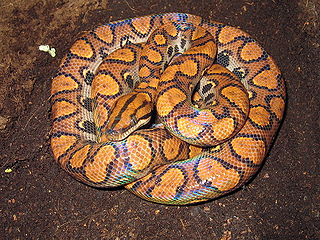
The rainbow boa is a boa species endemic to Central and South America. A semi-arboreal species, it is known for its attractive iridescent/holographic sheen caused by structural coloration. Five subspecies are currently recognized, including the nominate subspecies described here.

Boa imperator is a large, heavy-bodied, nonvenomous species of snake in the genus Boa that is commonly kept in captivity. Boa imperator is part of the family Boidae and is found in Mexico, Central America and South America west of the Andes Mountains. It is commonly called the Central American boa, northern boa,common boa, common northern boa and Colombian boa and is frequently and erroneously referred to as the red-tailed boa or Colombian red-tailed boa, especially in the pet trade.
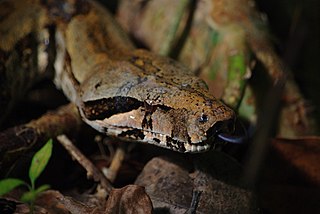
Boa orophias, the San Lucia boa, is a species of snake in the family Boidae. The species is endemic to Saint Lucia. Boa orophias was described as a full species by Carl Linnaeus in 1758, but many later authors have classified it as a subspecies of Boa constrictor. According to the IUCN Red List, Boa orophias is a species, which they have listed as Endangered.
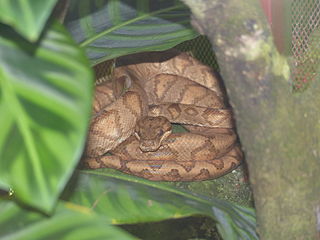
Corallus annulatus, known as the ringed tree boa, annulated tree boa, and northern annulated tree boa, is a boa species found in Central and South America. Three subspecies are currently recognized, including the nominate subspecies described here. Like all boas, it is a non-venomous constrictor.

The Bahamian pygmy boa constrictor, also known as the Inagua trope or Bahama wood snake, is a species of nonvenomous snake in the family Tropidophiidae. The species is endemic to Great Inagua Island in the Bahamas.
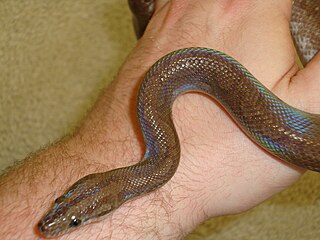
Epicrates maurus is a species of non-venomous constrictor in the family Boidae, commonly found in the Amazon region of South America. The common name for this species is the brown rainbow boa. This species is semi-arboreal, spending time both on the ground and climbing trees and shrubs, although they are also known to swim. They are nocturnal and primarily active in the middle of the night. Rainbow boas are known for their attractive iridescent sheen on their scales in the sunlight.
Imperator is a title used in the Roman Republic.
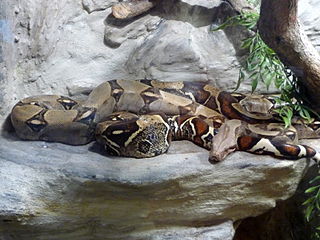
The boa constrictor, also known as the red-tailed boa, is a species of large, non-venomous, heavy-bodied snake that is frequently kept and bred in captivity. The boa constrictor is a member of the family Boidae. The species is native to tropical South America. A staple of private collections and public displays, its color pattern is highly variable yet distinctive. Four subspecies are recognized. This article focuses on the species Boa constrictor as a whole, and on the nominate subspecies B. c. constrictor.
Klossiella is a genus of parasitic alveolates of the phylum Apicomplexa. Species in this genus infect the renal tract of mammals and intestinal tract of snakes.

Afrânio Pompílio Gastos do Amaral was a Brazilian herpetologist.
The Crawl Cay boa is a dwarf Boa imperator population that reaches a maximum length of about 5 feet. Characteristics of this snake are the very gray background colour with black speckling which is also on the head. The snakes have saddling like the common boa, which continue onto the tail.

Boa constrictor occidentalis, also commonly known as the Argentine boa, is a subspecies of large, heavy-bodied, nonvenomous, constricting snake. Boa constrictor occidentalis is a member of the family Boidae, found in the subtropical temperate west of Argentina and Paraguay, although some members have been reported to exist in Bolivia as well.
"Boa Constrictor" is a song written by Shel Silverstein and originally featured on his 1962 album Inside Folk Songs.
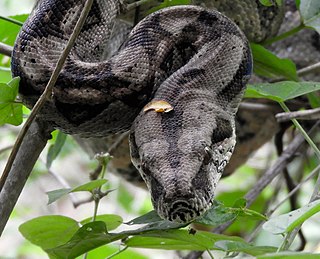
Boa sigma, known commonly as the Mexican west coast boa, is a species of snake in the family Boidae. The species is endemic to western Mexico. Boa sigma has previously been regarded as conspecific with Boa constrictor, and later with Boa imperator; however, in 2016, it was suggested on genetic grounds that Boa sigma should be regarded as a separate species.











